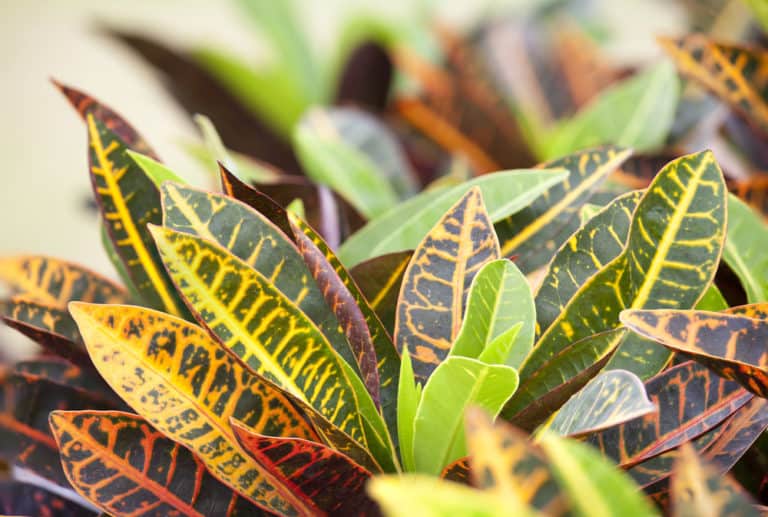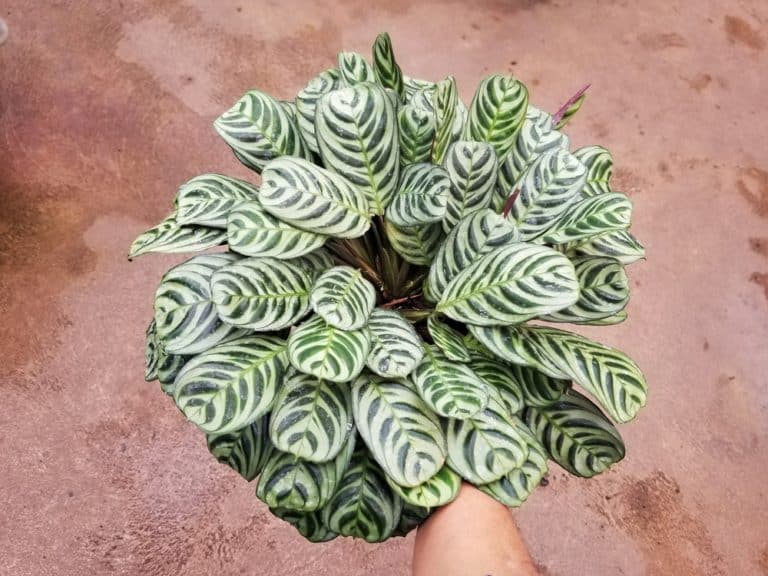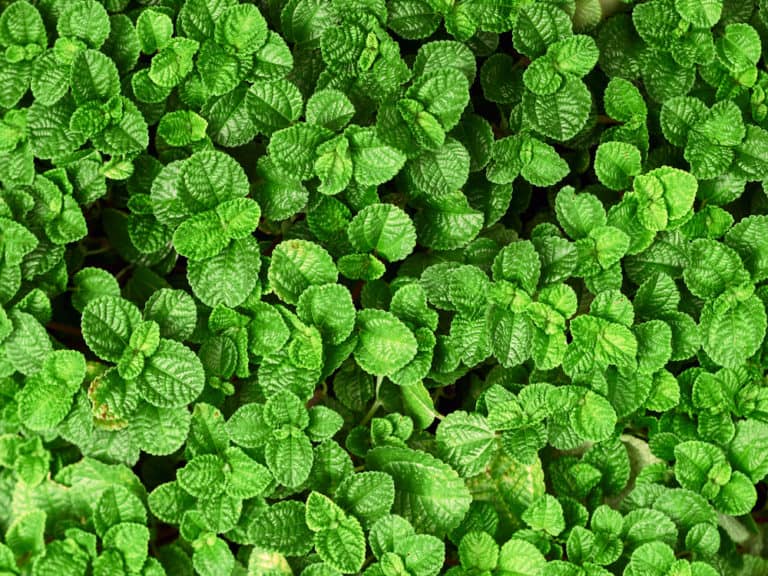Xerosicyos Danguyi ‘Silver Dollar Vine’ Care Guide (2024)

The Silver Dollar Vine is a succulent plant that will happily adapt to a wide range of growing conditions, indoors or outside.
The round, plump leaves of Xerosicyos danguyi grow profusely on this slow-growing vine, which can be trained up a trellis or allowed to trail from a hanging planter.
| Scientific Name | Xerosicyos danguyi ‘Humbert’ |
| Common Name | Silver Dollar Vine, Penny Plant, String of Coins |
| Light | Full sun |
| Watering | Monthly |
| Temperature | 68 to 80ºF (20 to 27ºC) |
| Hardiness Zone | 9b to 11b |
| Humidity | 40% or less |
| Soil Type | Light, quick-draining |
| Soil pH | 6 to 6.5 (mildly acidic) |
| Fertilizing | A balanced feed once a year |
| Repotting | Every 1 or 2 years |
| Pruning | Spring and summer |
| Propagation | Root in water or soil |
| Toxicity | Not toxic to humans and pets |
| Mature Size | 12 feet as a houseplant |
| Bloom Time | Spring |
What’s Unique About Silver Dollar Vine?
There are several different plants with the common name of Silver Dollar.
This Silver Dollar Vine plant is the Xerosicyos danguyi vine, native to Madagascar.
They are considered lianas, which are woody vines that climb trees to reach for the sun.
Silver Dollar Vine plants are easily identifiable by its perfectly round, matte green leaves, growing all over the long vines.
Growing Silver Dollar Vine is pretty easy, even for beginners. It tolerates a fairly wide temperature range and prefers infrequent watering.
It’s also a perfect plant for pet (or person) parents, as they are non-toxic to humans and animals.
Silver Dollar Vine Care
In the west and south-west of Madagascar where Xerosicyos danguyi originates, the climate is semi-desert.
Your Silver Dollar Vine plant care should reflect those growing conditions, where there’s little tree cover and water for the native plants.
Good Xerosicyos danguyi care means keeping your vine on the dry, warm side, and giving it full sun.
Light
In the dry regions of Madagascar, there are no towering trees to cast their shade.
Thus, Silver Dollar Vine light requirements are for full sun for 6 to 8 hours a day, or about 40,000 to 100,000 lux.
You can keep your Silver Dollar Vine in bright, indirect light if that’s your only option, but they will grow better with direct sunlight.
You can best meet Xerosicyos danguyi light needs by growing the vine in a sunny south or west-facing window.
However, if leaves start to show some signs of sunscald, hang a light curtain between the plant and window when the sun is most intense.
Watering
Southwest Madagascar is a semi-desert region, with less than 800 mm of rain every year.
Your Silver Dollar Vine watering should be infrequent so as not to kill this succulent plant with too much water.
Water Xerosicyos danguyi when the soil has completely dried out, or when the leaves start to look a little wrinkled.
The best way to meet your Silver Dollar Vine’s watering needs is to put the whole pot in a pail of water and let it get completely saturated. Then, give it time to drain out all excess water before setting it back in its saucer.
Temperature
The Silver Dollar Vine temperature range is between 68 to 80ºF (20 to 27ºC) during the day and 50 to 70ºF (10 to 21ºC) at night during its growing season.
They won’t mind heat waves up as high as 104ºF (40ºC), so a summer on the patio is perfect for them.
In winter, however, the best temperature for Xerosicyos danguyi is 41 to 48ºF (5 to 9ºC).
They do have a fairly wide temperature tolerance, and will survive a light frost of 25ºF (-5ºC).
Their hardiness does not extend beyond that, so in temperate zones it is recommended that you bring them in for the winter months.
Humidity
In its native semi-desert climate, the Silver Dollar Vine, not surprisingly, is used to low humidity.
This makes it an ideal houseplant, as Silver Dollar Vine humidity requirements are well within normal household levels.
The ideal humidity for Xerosicyos danguyi is 40% or less, which is a pretty standard indoor humidity level.
You will probably not find it necessary to use any methods to increase the moisture in the air around your Silver Dollar Vine.
In fact, you should worry about too much humidity for your Silver Dollar Vine, as that can foster bacterial or fungal diseases that thrive on moisture.
Soil
In its native habitat, the Silver Dollar Vine grows in light, sandy, well-draining soil.
It will not tolerate soggy, water-logged soil, which will make the development of root rot very likely.
The best pH level for Xerosicyos danguyi is 6 to 6.5, or mildly acidic.
A good Silver Dollar Vine soil is a commercial cactus or succulent soil mix, to which you won’t need to add anything.
However, you can also make your own soil for Xerosicyos danguyi.
Equal parts of potting soil, perlite, and coarse sand will make a good, porous growing medium for your Silver Dollar Vine.
Fertilizer
You will not need to use much Silver Dollar Vine fertilizer, but an annual light feeding will help it grow its best.
Aim for a fertilizer ratio of 20-20-20, and consider using a granular slow-release fertilizer to spread out the available nutrients over the growing season.
Simply spread it over the top of the soil and work it in a bit to the top inch or so.
You can also use a liquid fertilizer for Xerosicyos danguyi, but be sure to dilute it to half the recommended strength to avoid damaging the roots.
Always feed right after you’ve watered, and pour it over the entire soil surface.
Potting & Repotting
You should probably plan on Silver Dollar Vine repotting once every 2 years, but if it starts to get rootbound, you can do it annually.
If the roots are starting to grow out of the drainage holes, or water drains right through because it’s all roots, it’s time for repotting Xerosicyos danguyi.
Only go up one pot size, as too much soil can cause overwatering problems for your Silver Dollar Vine. Choose an unglazed clay pot with good drainage holes.
Even if your Silver Dollar Vine isn’t rootbound, refreshing the potting soil every two years can help keep your plant growing well.
Pruning
Silver Dollar Vine pruning should be done regularly to keep this rambling, bushy vine under control.
Cutting Xerosicyos danguyi to shape it should be done during its growing season in spring and summer.
Wherever you feel your Silver Dollar Vine is getting too long, simply cut just below a node, on a 45 degree angle.
Always use sterilized shears when cutting your Silver Dollar Vine.
Of course, you should trim dead or damaged leaves or spent flowers off of your Silver Dollar Vine at any time of the year. Not only do they look messy, but they can be a vector for disease and insects.
Propagation
While it is possible to propagate Xerosicyos danguyi from seeds, you will get a reasonably sized plant much more quickly when you use stem cuttings.
The best time for Silver Dollar Vine propagation is in early spring.
Select a vine growing off of the main stem, and cut a 4 to 5 inch length with at least a couple of nodes.
Strip off all but the top leaves, and let the stem cutting sit for a few days to let the cut end develop a callus.
Then, put your stem cuttings in a moist growing medium and keep them in a warm spot.
Within a few weeks you should see roots developing, and you can then plant out each Silver Dollar Vine baby in its own pot.
Common Problems of Silver Dollar Vine
There are few potential Silver Dollar Vine problems, and most can be prevented through good cultural practices.
Most problems with Xerosicyos danguyi are the result of too much water, whether it’s on the soil or on the leaves.
These plants are pretty resilient and should bounce back once you’ve resolved the problem.
Pests
The two most likely Silver Dollar Vine pests are mealybugs and aphids. Luckily, both are easy to eliminate and there are ways to discourage them from turning up in the first place.
A monthly spritzing of your Xerosicyos danguyi with a solution such as insecticidal soap or neem oil will act as a deterrent for these bugs.
Mealybugs will leave yellow or brown spots on the leaves, and if you look you will see what look like tufts of cotton on the underside of the leaves. You can wipe them off with a cotton ball soaked in rubbing alcohol.
Aphids are small green flies that gather under the leaves. Spray them off or get rid of them with a hand vacuum.
Diseases
Of the few Silver Dollar Vine diseases, you are most likely to see root rot if you have been overwatering your plant.
It is vital that you let the soil dry out between waterings, and that you use a porous soil mix.
If your Xerosicyos danguyi has root rot, leaves will turn yellow and the stems will get mushy. The roots start to blacken and have a foul smell.
Cut off all infected parts and repot your Silver Dollar Vine in fresh soil in a disinfected pot.
Powdery mildew can develop if you don’t keep the leaves dry. Keep the leaves dry and improve air circulation around the plant.
Growing Problems
There are really very few potential Silver Dollar Vine growing problems, and most of them are easily solved, so your sick plant should soon be thriving again.
If the leaves of your Xerosicyos danguyi are dropping off, you are probably overwatering it.
If the soil is really saturated, it’s probably best to replant it in fresh, porous soil. Waiting too long for the soil to dry out may lead to root rot.
If leaves are yellowing, and your Silver Dollar Vine is growing slowly with stunted side shoots, you should give your plant some fertilizer.
Don’t overdo it, though, as too much fertilizer will also damage the plant.
Toxicity of Silver Dollar Vine
Xerosicyos danguyi is not toxic to humans or animals, unlike so many tropical natives grown as houseplants.
Because of its lack of toxicity, it’s a good choice in homes with pets and young children, but you should still exercise some caution when it comes to their access to the plants.
For Humans
Silver Dollar Vine is not toxic to humans, but this does not mean you should let your children handle this or any other houseplant without supervision.
While there are no toxic substances in the tissues of the Silver Dollar Vine, you may be using insecticidal sprays that children should not be exposed to, even if they’re organic.
Small children might also cause damage to the plant by pulling off the intriguingly shaped leaves, which you certainly don’t want.
As well, children won’t be able to distinguish between which plants are safe and which ones are poisonous, so a general hands-off policy is best.
For Pets
While the Silver Dollar Vine is not toxic to pets, it’s still a good idea to keep this and all of your houseplants out of their reach.
Cats and dogs are carnivores by nature, and while they will eat plant matter sometimes, too much can cause digestive issues.
The good news is that it won’t kill them, and you won’t have to take them in for an expensive emergency visit to the veterinarian.
The bad news is that they may have several hours of vomiting and diarrhea. That’s not going to be fun for anyone.
A bored indoor cat can also do a lot of damage to a plant, so you will want to avoid that as well.
Silver Dollar Vine Appearance
Whether you’ve got a new, young Silver Dollar Vine, or a mature vine stretching for many feet, the Silver Dollar Vine appearance is attractive year-round.
The small, round leaves hanging from the vines in large numbers are fresh and green in all seasons, creating a soothing oasis indoors or outside.
Foliage
The foliage of Silver Dollar Vine is, of course, what gives it all of its common names, and you can easily deduce what the leaves look like.
A Silver Dollar Vine leaf is almost perfectly round or slightly oval, and is thick and fat with very subtle veins. Occasionally they have a slight tip. They average 1.5 inches across.
The succulent leaves are plump and hard when they mature, although they can be quite tender when they first emerge.
Young leaves are brownish, changing to a silvery green later. They have a matte texture.
They have multiple leaves on each stem in an alternating leaf arrangement.
Flowering
The Xerosicyos danguyi flower will appear when your vine is several years old and has attained sufficient maturity. This can happen on plants grown indoors or outdoors.
Silver Dollar Vine flowering occurs in spring and early summer.
Flowering is more likely when you have kept your Silver Dollar Vine in a dormant stage through the winter, with low temperatures and infrequent watering.
When it is blooming, you will see small clusters of pale yellow flowers. They have no scent.
Before you get excited about being able to plant seeds from your Silver Dollar Vine, be aware that you need to have a female and a male plant cross-pollinate to produce seeds.
Size and Growth
Silver Dollar Vine has a moderate to fast growth rate, and within 10 years the central stem can reach 12 feet in length, and 5 feet across.
Outdoors in a tropical or subtropical zone, a Silver Dollar Vine can be 16 feet by the time it’s finished growing.
You can control the size of Silver Dollar Vine by pruning it to fit within your parameters.
The Silver Dollar Vine has a thick central stem that becomes woody as it matures. It has tendrils that grab onto supports such as tree trunks or trellises to climb upwards.
It can also be grown in a hanging planter with trailing stems.
Silver Dollar Vine Fragrance
There is no Silver Dollar Vine fragrance.
While this perennial vine does produce flowers in spring, they have no scent, and the evergreen foliage is fragrance-free.
Combined with its extremely low care requirements, Silver Dollar Vine’s lack of fragrance makes it an ideal plant for use in public installations.
Many places such as hotels, schools, nursing homes and retail establishments prefer to use plants that have no scent.
There’s a growing realization that a certain percentage of the population has allergies or sensitivities to strong scents. Plants without fragrance are safer in such settings.
You may even prefer a scentless plant in your own home, especially in a small space where a heavy perfume would be overwhelming.
Suggested Uses for Silver Dollar Vine
Silver Dollar Vine is an easy to care for houseplant with a lot of design potential.
Indoors, you can train your Silver Dollar Vine up a trellis, creating a living screen to section off a space of a room. This is particularly useful in a small apartment where spaces need to do double or triple duty.
Since it prefers full sun, you could even use a Silver Dollar Vine in a hanging basket in front of a window to screen an ugly view with a southern exposure, as it loves full sun.
Move your Silver Dollar Vine outdoors for the summer, and let it linger through the early fall as it will tolerate lower temperatures than most other tropical plants.
FAQ
What is Silver Dollar Vine?
Silver Dollar Vine is a succulent vine native to Madagascar, where it grows in semi-desert conditions. It is grown as a houseplant in temperate zones and as a landscape plant in tropical climates.
How to identify Silver Dollar Vine?
Silver Dollar Vine has small, round, silvery green leaves growing alternately on stems growing off of a central vine, which becomes woody when it matures.
How to care for Silver Dollar Vine?
Silver Dollar Vine should be grown in full sun in warm but dry conditions, watered only when the soil is dry and fertilized once a year.
How to grow Silver Dollar Vine indoors?
Silver Dollar Vine can be grown indoors as a climbing vine or a hanging plant. In its dormant phase in winter it should be kept in a cool location.
How to grow Silver Dollar Vine outdoors?
Silver Dollar Vine can be grown outdoors as a landscape plant in zones 9 to 11, or can be moved outdoors in summer in regions with cold winters.
How fast does Silver Dollar Vine grow?
Silver Dollar Vine has a moderate growth rate, taking about 10 years to reach its mature size, whether it is grown indoors or outside all year.
How tall does Silver Dollar Vine grow?
Silver Dollar Vine can reach 12 feet in length when grown indoors as a potted plant, or 16 or more when grown outdoors in suitable climates.
How to make Silver Dollar Vine grow faster?
Silver Dollar Vine will grow its fastest when kept in temperatures around 80ºF (27ºC), in full sun for much of the day. Do not over-fertilize to encourage growth.
How to stake Silver Dollar Vine?
Silver Dollar Vine can be trained up a trellis, as its tendrils will grab onto supports and help it climb. You can also plant it in a hanging basket.
How to pot Silver Dollar Vine?
Silver Dollar Vine should be potted in a porous, sandy soil mix in an unglazed clay pot with drainage holes to help regulate the soil moisture.
How to revive Silver Dollar Vine?
If your Silver Dollar Vine has dried out completely, you may still be able to revive it by soaking the pot thoroughly in a pail of tepid water.
Why is my Silver Dollar Vine dying?
Your Silver Dollar Vine may have root rot, a fungal disease encouraged by overwatering. Cut off all affected parts and repot it in fresh soil.
Why is my Silver Dollar Vine drooping?
Your Silver Dollar Vine may be very dry, or too wet. Either give it a thorough soaking or repot it in loose, well-draining soil with lots of sand.
How cold can Silver Dollar Vine tolerate?
Silver Dollar Vine will grow best between 68 to 80ºF (20 to 27ºC), but will tolerate brief periods of temperatures as low as 25ºF (-5ºC).
How to get rid of pests on Silver Dollar Vine?
Silver Dollar Vine pests can be removed by wiping them off or spraying the plant with water, and then using an insecticidal soap or neem oil spray.
Is Silver Dollar Vine toxic to cats?
No, Silver Dollar Vine is not toxic to cats. However, cats can have gastrointestinal issues when they eat too much plant material, so they may have vomiting and diarrhea.
Is Silver Dollar Vine toxic to dogs?
No, Silver Dollar Vine is not toxic to dogs, but since they are carnivores, they have difficulty digesting vegetable matter and may have a bout of vomiting and diarrhea.
Is Silver Dollar Vine toxic to children?
No, Silver Dollar Vine is not toxic to children. However, because of sprays and fertilizers used on plants, you should discourage them from handling it.
Is Silver Dollar Vine toxic to humans?
No, Silver Dollar Vine is not toxic to humans. You do not have to take any precautions to avoid exposure to the tissues or sap.
Does Silver Dollar Vine have a scent?
No, neither Silver Dollar Vine flowers nor leaves have a scent. They can be safely used in public settings where people with fragrance sensitivities may be exposed to them.






